The AMD Ryzen 9 3950X Review: 16 Cores on 7nm with PCIe 4.0
by Dr. Ian Cutress on November 14, 2019 9:00 AM ESTGaming: Grand Theft Auto V
The highly anticipated iteration of the Grand Theft Auto franchise hit the shelves on April 14th 2015, with both AMD and NVIDIA in tow to help optimize the title. GTA doesn’t provide graphical presets, but opens up the options to users and extends the boundaries by pushing even the hardest systems to the limit using Rockstar’s Advanced Game Engine under DirectX 11. Whether the user is flying high in the mountains with long draw distances or dealing with assorted trash in the city, when cranked up to maximum it creates stunning visuals but hard work for both the CPU and the GPU.
For our test we have scripted a version of the in-game benchmark. The in-game benchmark consists of five scenarios: four short panning shots with varying lighting and weather effects, and a fifth action sequence that lasts around 90 seconds. We use only the final part of the benchmark, which combines a flight scene in a jet followed by an inner city drive-by through several intersections followed by ramming a tanker that explodes, causing other cars to explode as well. This is a mix of distance rendering followed by a detailed near-rendering action sequence, and the title thankfully spits out frame time data.
There are no presets for the graphics options on GTA, allowing the user to adjust options such as population density and distance scaling on sliders, but others such as texture/shadow/shader/water quality from Low to Very High. Other options include MSAA, soft shadows, post effects, shadow resolution and extended draw distance options. There is a handy option at the top which shows how much video memory the options are expected to consume, with obvious repercussions if a user requests more video memory than is present on the card (although there’s no obvious indication if you have a low end GPU with lots of GPU memory, like an R7 240 4GB).
All of our benchmark results can also be found in our benchmark engine, Bench.
| AnandTech | IGP | Low | Medium | High |
| Average FPS | 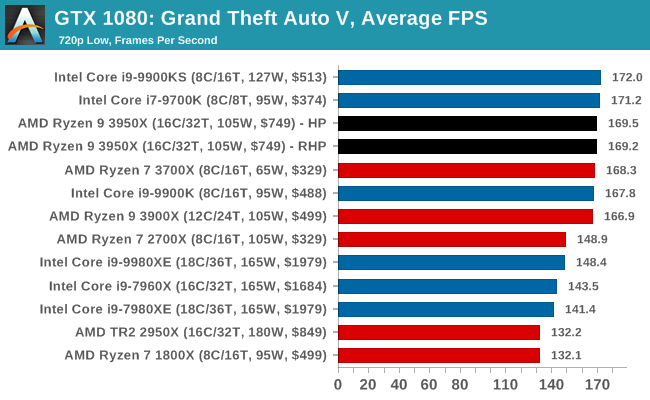 |
 |
 |
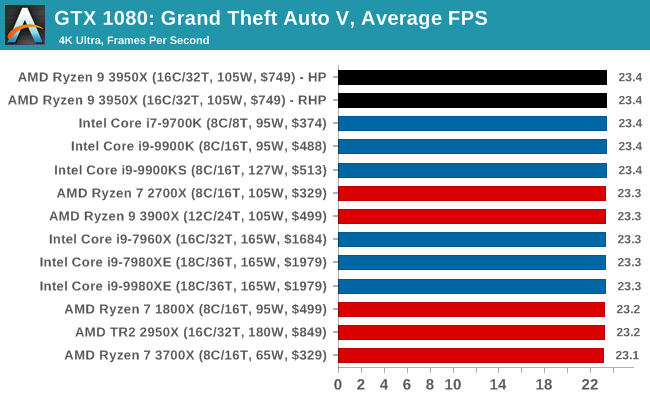 |
| 95th Percentile | 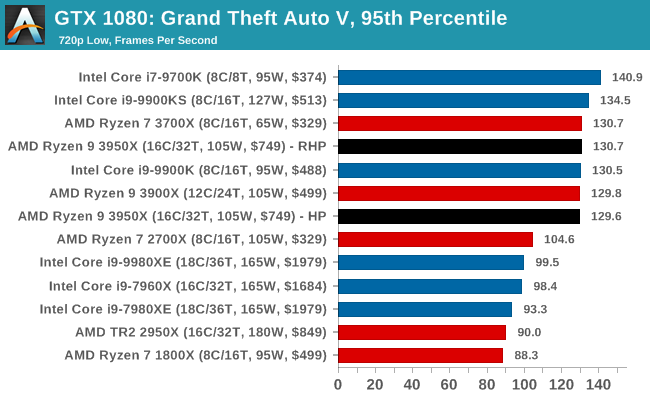 |
 |
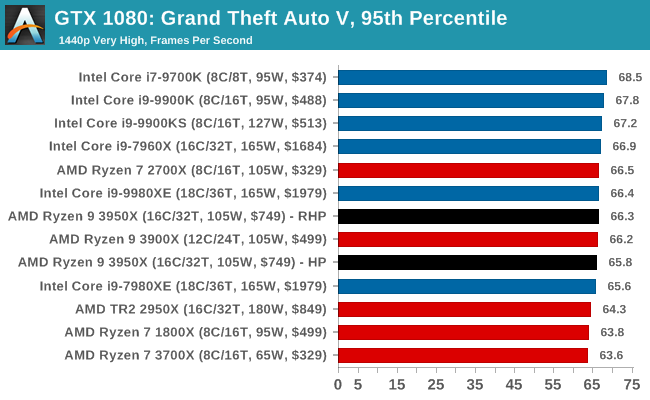 |
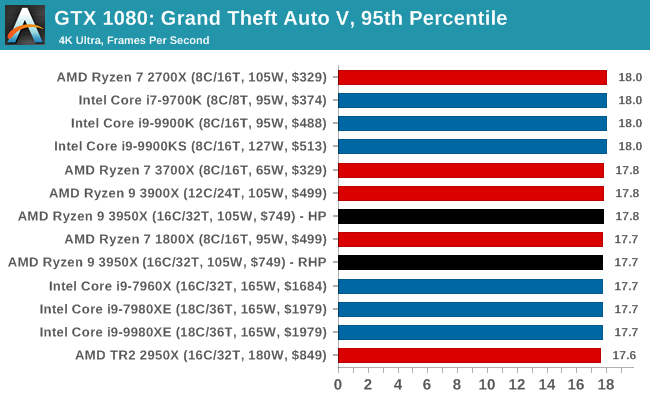 |












206 Comments
View All Comments
Ian Cutress - Thursday, November 14, 2019 - link
Different software was saying different values depending on which sensor. I'm going to go back at some point and see if I can figure out why some were +30C over others.eastcoast_pete - Thursday, November 14, 2019 - link
Thanks Ian! I agree that, right now, the 3950X is King of the Hill in the HEDT space. Two minor flies in the otherwise good Zen 2 ointment:1. To fit the 3950X into the target thermal envelope, AMD reserves the best 7 nm dies for the 3950X, at least for now (pending Threadripper). While that makes sense business wise, it means a much lower chance for the rest of us to score a great die in the binning lottery. The fun with earlier Zen chips was that one could, with some luck, get a great die in a mainstream chip. Apparently, no more. The mainstream Ryzens are still very good, but the idea of getting a little something extra added appeal.
2. AMD has advertised the 3950X as targeted for liquid cooling. I know a lot of those who buy it will do so anyway, but there are some "air heads" left, including this one. I look forward to a comparison of liquid vs high-end and mainstream air coolers.
Overall, a great chip, that will keep Intel running to catch up, and that's good for all of us!
hansmuff - Thursday, November 14, 2019 - link
Isn't (1) pure speculation? As far as (2) goes, even with the 3900X AMD was saying that the top frequencies need enhanced cooling, and that's not particularly true. Even on a good AIO, we're not seeing the 3900X performing better than on good air. The 3950X has similar thermal envelopes, so I think a good air cooler will be just dandy.eastcoast_pete - Thursday, November 14, 2019 - link
The binning part (1) was mentioned in an article in golem.de . That site is usually pretty reliable, despite their name.abufrejoval - Friday, November 15, 2019 - link
While it's one of my favorites, too, I doubt that in this specific case they have any insights AT lacks. I believe they editorialized that part.But of course sophisticated binning is a core part of the CPU business these days.
And another good one with exclusive news gems every now and then is this one: https://elchapuzasinformatico.com/
Irata - Thursday, November 14, 2019 - link
Does AMD consider the 3950X to be HEDT ? Thought it was part of their mainstream platform.Ratman6161 - Thursday, November 14, 2019 - link
No. the 3950x is not HEDT. Its performance blurs the lines a bit but HEDT is more than just the CPU. Its also about PCIe lanes and RAM capacity etc.Ratman6161 - Thursday, November 14, 2019 - link
"the 3950X is King of the Hill in the HEDT space"The 3950x is not in the HEDT space. That's one of the most important conclusions I take away from this review. 3950x runs on a regular desktop motherboard (albeit an x570 to get full advantage of it). So besides just the price of the CPU itself, it makes everything about the system less expensive as well. My conclusion is that the 3950X is the best overall performance you can get from something that is not HEDT. This makes it much more accessible to us mere mortals...though personally I'm still looking at the 3700X.
eastcoast_pete - Thursday, November 14, 2019 - link
I guess one person's high-end desktop is another one's mainstream. I call a CPU that, yes, costs more than twice than a standard 8 core, yet is also faster than many other "HEDT" CPUs HEDT. In my view, HEDT is still below workstation levels, which have all the goodies you mention such as many more PCIe lanes, quad or more memory channels, support error correcting memory and lots of it, and are often multi-socketed. But then, the prices for these is eye-watering. But, regardless, this is a fast CPU.phoenix_rizzen - Thursday, November 14, 2019 - link
Time for another category, then. :)This is definitely a high-end desktop CPU. Runs in a mainstream desktop motherboard, and performs better than pretty much every other mainstream desktop processor.
Maybe it's time to call the Intel -X and AMD Threafripper lines "workstation-class" or "high-end workstation" or something along those line.
So you get desktop, workstation, and server. With low-end/high-end sub-groups for them.
So Athlon 3000G and Ryzen 3 would be low-end desktop. Ryzen 5 and 7, and the APUs, would be normal desktop. Ryzen 9 would be high-end desktop.